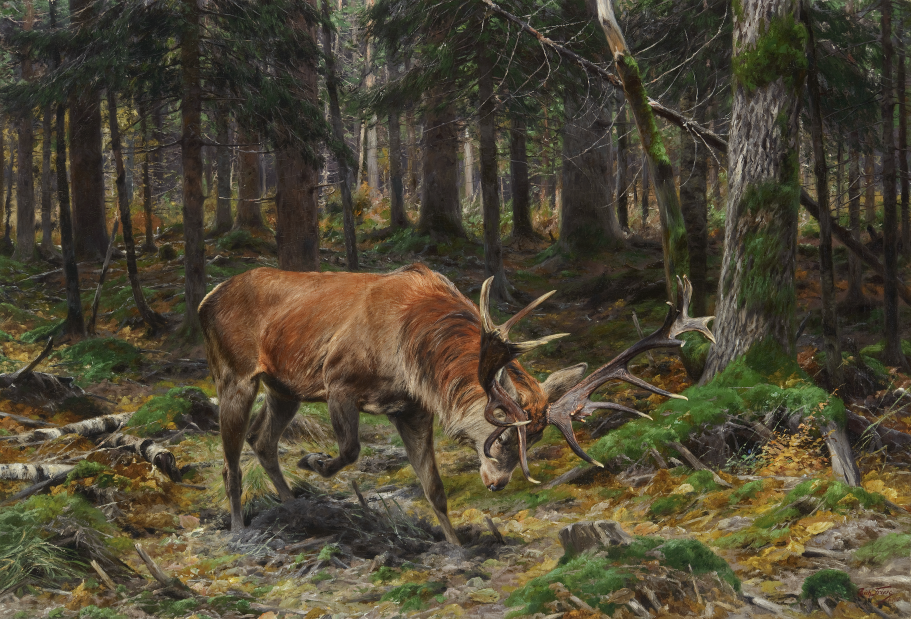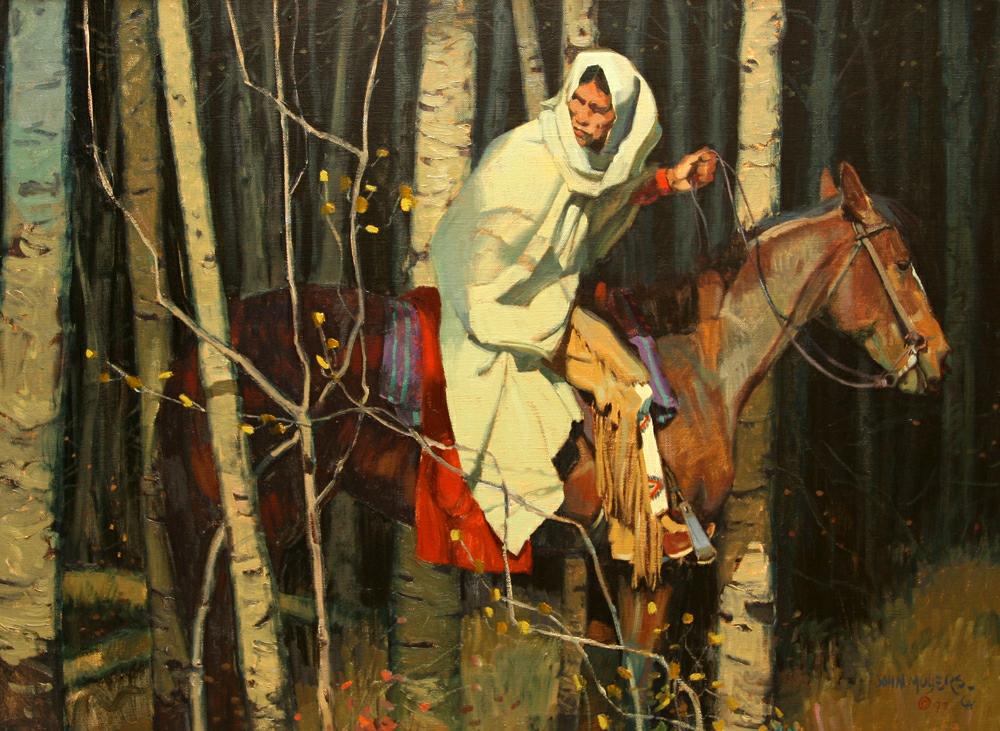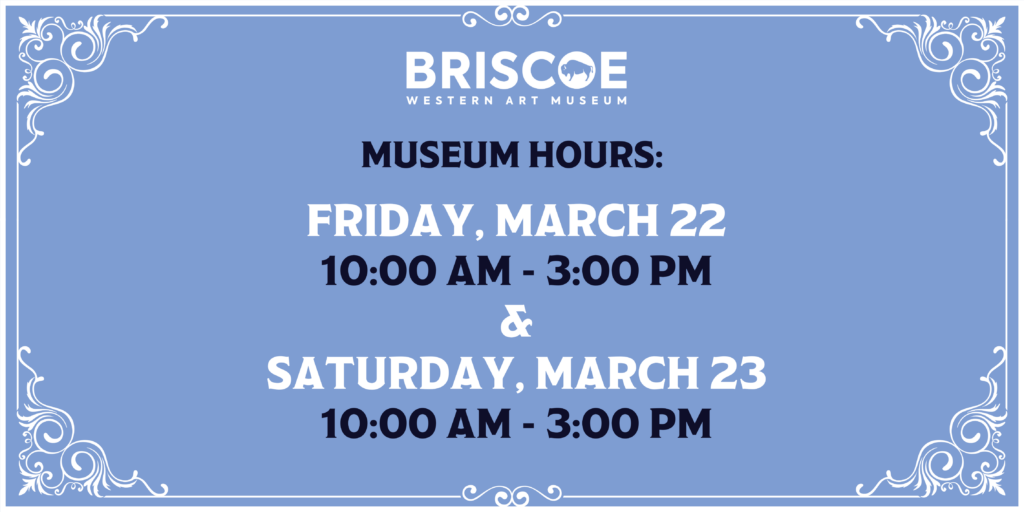- Visit
Briscoe Western Art Museum
Explore the art and artifacts that bring the stories of the West to life.
- Exhibitions
2024 Night of Artists
One of the premier Western art events in the world with the viewing and sale of new works by today’s leading contemporary Western artists.
- Learn
Briscoe Learning Opportunities
Whether you’re planning a family trip, a date night or a field trip, The Briscoe has a wide range of educational activities for all age groups.
- Support
Become a Briscoe Member
Support the museum’s mission to preserve and promote the shared heritage of the American West.
Upcoming Exhibitions
Art, history, and popular culture provide mirrors in which we can see ourselves in the context of our time. The story of the West connects us all and continues today. The museum’s temporary exhibitions paint a picture of the American West through historic and contemporary art and artifacts.
Survival of the Fittest

Richard Friese, Deer in a Forest Glade, 1912, oil on canvas, 49.75 x 77.25 in.
On Loan JKM Collection, National Museum of Wildlife Art
Survival of the Fittest:
Envisioning Wildlife and Wilderness with the Big Four, Masterworks from the Rijksmuseum Twenthe and the National Museum of Wildlife Art
June 14, 2024 – September 8, 2024
Survival of the Fittest features approximately 50 masterworks created by an influential group of painters known today as the Big Four. Working during the late 1800s and early 1900s, these artists established a vision of wildlife and wilderness that remains with us to this day. Their careers also influenced generations of artists interested in painting wildlife in the 20th century. Members of the Big Four include American Carl Rungius (born Germany, 1869 – 1959), Germans Richard Friese (1854 – 1918) and Wilhelm Kuhnert (1865 – 1926), as well as Bruno Liljefors (1860 – 1939) from Sweden.
Representations of wildlife in natural habitats, though common today, were not always the norm. The popularization of Charles Darwin’s theories on evolution in the middle to late 1800s began a shift (especially among European-Americans) toward understanding wildlife and nature together. Faced with the destructive legacy of European colonial expansion, an emerging conservation movement sought to preserve the land and animals that remained. Government surveys and scientific expeditions began traveling into remote regions to study wildlife and natural habitats, often accompanied by an artist. Soon thereafter, artists began traveling to study intact wildlife populations on their own.
The artists of the Big Four, working at the same time but in separate regions of the globe, broke new ground by picturing wild animals in ways that had not been widely seen before by Europeans or Americans. Their powerful images gave eager audiences a way to see what lay beyond urban centers and brought a new vision of the wild into increasingly domesticated lives. Their paintings did not feature animals from biblical narratives or scenes from popular fables but instead emphasized the importance of seeing creatures in their natural habitats, enacting natural behaviors. The artwork of the Big Four was transformational in its presentation of a vision that valued the animal and its habitat as two inseparable and interdependent parts of a larger ecological system.
Storytellers

John Moyers, Voices in the Night, 1997, oil on canvas, 39.75 x 49.5 in.
Storytellers
Narrative Art & The West
October 3, 2024 – January 19, 2025
This exhibition explores the various ways artists have told stories about the Southwest in their work. From illustrations of historic events, such as Diego Romero’s images of the Pueblo Revolt and paintings of regional religious ceremonies like William Penhallow Henderson’s Holy Week in New Mexico, to ruminations on spiritual traditions as in Patrocinos Barela’s The Last Supper, the narratives of the West reflect various points of view to tell the story of this special place. Ranging from the celebratory to the satirical, these works reflect on modern art, as shown by John Sloan or Gustave Baumann, comically lampoon contemporary society, and expand on iconic images of the pop culture West as seen in W. Herbert Dunton’s illustration for “The Fair in the Cow Country” and Billy Schenck’s pop cowboys.
Narrative art tells a story. It can illustrate historic events or bring the imagination to life. It can be somber, humorous, didactic, ironic, and often entertaining. The traditions of storytelling in the Southwest can be traced back to ancient times and to the Indigenous populations of the region. Later, the West held a special place in the American imagination providing a canvas for the expression of the nation’s hopes, fears, and aspirations. The topics of these stories include the everyday, agriculture, ecology, celebrations, grief, and regional history.
Discover More as a Member
Get Art and Updates in your Inbox
- About Us
- Contact
- Press Room
- Public Library Portal
- Employment
- About Us
- Press Room
- Contact

Briscoe Western Art Museum
210 W. Market Street
San Antonio, TX 78205
T. 210.299.4499
F. 210.299.4118
info@briscoemuseum.org
© 2023 The Briscoe Western Art Museum. Powered by Tribu Creative
